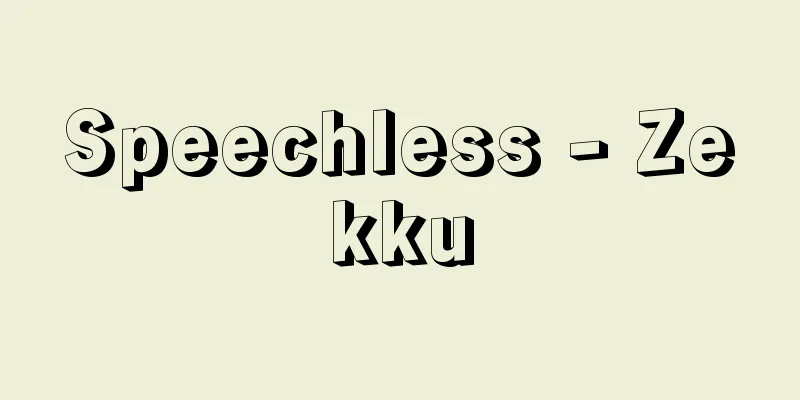Speechless - Zekku

|
A style of poetry in classical Chinese poetry. It is the smallest style of poetry, consisting of four lines. There are two types: "five-character jejuku" with five characters per line, and "seven-character jejuku" with seven characters. There are also six-character jejuku, but they have not become common. There are various theories about the name jejuku, such as that it is a semi-completed version of a regulated poem (poem of eight lines), or that it means one line and one complete jeju. The origin of the five-character jejuku is folk songs such as "Ziye Ge" and "Xiqu Ge" that were popular in the lower and middle reaches of the Yangtze River during the Jin and Song dynasties of the Six Dynasties. [Koyoka] As with all seven-character styles, seven-character quatrains arose rapidly from the end of the Six Dynasties to the Tang Dynasty, piggybacking on the development of five-character quatrains, and the style was established by the end of the early Tang Dynasty. Both five-character and seven-character quatrains reached their peak during the prosperous Tang Dynasty, but seven-character quatrains in particular flourished as the most universal style. As the smallest poetic style, quatrains require sharp ideas, senses, and expressions, and also place importance on the lingering feeling that lingers outside the words, which is the unspoken emotion. [Wang Weiluchai (Rokusai)] [Tadahisa Ishikawa] “Shin Taishi Poetry” by Shoichi Takagi (included in “Chinese Culture Series 4: Introduction to Literature”, 1967, Taishukan Shoten)” Source: Shogakukan Encyclopedia Nipponica About Encyclopedia Nipponica Information | Legend |
|
中国古典詩の詩体の一つ。四句からなるもので、最小の詩体である。一句の字数が五字の「五言(ごごん)絶句」、七字の「七言(しちごん)絶句」の2種がある。六言のものもあるが、一般的にならなかった。絶句の名称は、律詩(りっし)(八句の詩)に半絶したもの、一句一絶の意など、諸説があって定まらない。五言絶句の源は、六朝(りくちょう)の晋(しん)・宋(そう)のころ、揚子江(ようすこう)の下流・中流地域に流行した「子夜歌(しやか)」「西曲歌」などの民歌である。 【子夜歌】 また七言絶句は、七言の体のすべてがそうであるように、五言の発展に便乗した形で、六朝末から唐にかけて急激におこり、初唐の末には体が定まった。そして五言、七言ともに盛唐に至って最高潮に達したが、とりわけ七言絶句はもっとも普遍的な体として盛行した。絶句は最小の詩体であるだけに、着想、感覚、表現に研ぎ澄まされた鋭さが要求され、また言外の情という、文字の外に漂う余韻を重んずる。 【王維鹿柴(ろくさい)】 [石川忠久] 『高木正一著『近体詩』(『中国文化叢書4 文学概論』所収・1967・大修館書店)』 出典 小学館 日本大百科全書(ニッポニカ)日本大百科全書(ニッポニカ)について 情報 | 凡例 |
>>: Seasonal festivals (festivals) - SEKKU
Recommend
Duke of Lerma
1553‐1625 Francisco Gómez de Sandoval y Rojas was ...
Yogarabhumi (English spelling)
…The basic text of the Yogacara school. The origi...
Eigaryu
…During the Muromachi period, the father and son ...
Cutting ties - Enkiri
Enkiri refers to human relationships in general, s...
Yellow lip
…The surface is yellowish-white, and when young, ...
Charlie
1862‐1934 Swedish astronomer. Professor of astrono...
Karaage - Fried chicken
...This also applies to bone crackers, which are ...
Flavanone
...For example, there are plant pigments such as ...
Eastern pygmy possum (English: Eastern pygmy possum)
A marsupial mammal of the Boulamysidae family. It ...
Ogetsuhime-no-kami - Princess Ogetsu
The name of a god that appears in the mythology of...
Hayashi Onri
Year of death: January 30, 1906 (Meiji 39) Year of...
Architecture
Overview General Provisions Architecture refers t...
Múspell (English spelling) Muspell
…There was neither earth nor heaven, only the mou...
Trireme
…These documents provide us with an insight into ...
Kango trade
Official trade conducted between the Ming Dynasty...









